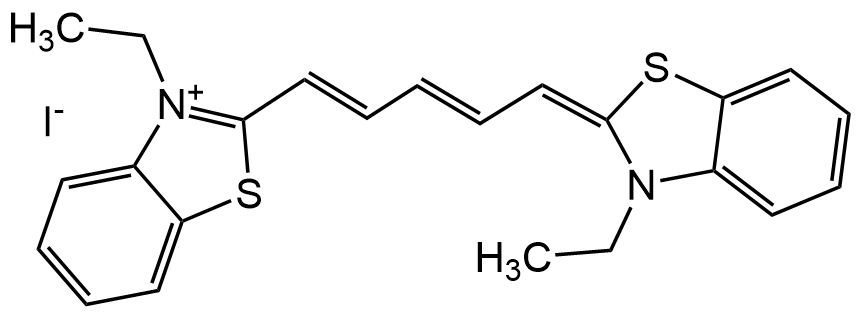
Chemical Structure
3,3-Diethylthiadicarbocyanine iodide
CDX-D0114
CAS Number514-73-8
Product group Chemicals
Estimated Purity>98%
Overview
- SupplierChemodex
- Product Name3,3-Diethylthiadicarbocyanine iodide
- Delivery Days Customer10
- CAS Number514-73-8
- CertificationResearch Use Only
- Estimated Purity>98%
- Scientific Description3,3-Diethylthiadicarbocyanine iodide (DiSC2(5); DTDCI), is a fluorescent near-infrared (NIR) dye. It belongs to the family of carbocyanine laser dyes. Due to its NIR fluorescence, it is used in various imaging techniques to visualize cells and tissues, and it is often used to study membrane potentials in cells because its fluorescence properties can change in response to membrane potential variations. DTDCI has strong absorption in the near-infrared region lambdaex = ~660nm. This region is particularly useful for biological applications as it allows for deeper tissue penetration and minimizes autofluorescence from biological samples. DTDCI emits fluorescence in the near-infrared (NIR) region. The exact lambdaem max typically occurs ~750-800nm, though this can vary slightly depending on the solvent and environment. The Stokes shift for DTDCI is relatively large, which is advantageous as it helps in reducing background interference and improving the signal-to-noise ratio in imaging applications. DTDCI, like many carbocyanine dyes, can be prone to photobleaching, where prolonged exposure to light causes a reduction in fluorescence intensity. Spectral data: lambdaex max = 651 nm. DTDCI is a monocationic dye which forms cofacial dimers that insert into the minor groove of DNA. It is also an effective broad-spectrum anthelmintic. DTDCI is used as a fluorescent contrast agent in three-dimensional fluorescence lifetime tomography and as a dye for rapid genetic screening. DTDCI is used as a tracer in cell biology. The dyes mechanism of action involves its ability to intercalate into lipid bilayers and selectively stain mitochondria, which may be useful for studying mitochondrial dynamics and function. - Chemical. CAS: 514-73-8. Formula: C23H23IN2S2. MW: 518.48. Soluble in DMSO. Slightly soluble in methanol or ethanol. 3,3-Diethylthiadicarbocyanine iodide (DiSC2(5); DTDCI), is a fluorescent near-infrared (NIR) dye. It belongs to the family of carbocyanine laser dyes. Due to its NIR fluorescence, it is used in various imaging techniques to visualize cells and tissues, and it is often used to study membrane potentials in cells because its fluorescence properties can change in response to membrane potential variations. DTDCI has strong absorption in the near-infrared region lambdaex = ~660nm. This region is particularly useful for biological applications as it allows for deeper tissue penetration and minimizes autofluorescence from biological samples. DTDCI emits fluorescence in the near-infrared (NIR) region. The exact lambdaem max typically occurs ~750-800nm, though this can vary slightly depending on the solvent and environment. The Stokes shift for DTDCI is relatively large, which is advantageous as it helps in reducing background interference and improving the signal-to-noise ratio in imaging applications. DTDCI, like many carbocyanine dyes, can be prone to photobleaching, where prolonged exposure to light causes a reduction in fluorescence intensity. Spectral data: lambdaex max = 651 nm. DTDCI is a monocationic dye which forms cofacial dimers that insert into the minor groove of DNA. It is also an effective broad-spectrum anthelmintic. DTDCI is used as a fluorescent contrast agent in three-dimensional fluorescence lifetime tomography and as a dye for rapid genetic screening. DTDCI is used as a tracer in cell biology. The dyes mechanism of action involves its ability to intercalate into lipid bilayers and selectively stain mitochondria, which may be useful for studying mitochondrial dynamics and function.
- Storage Instruction-20°C,2°C to 8°C
- UNSPSC41116134
